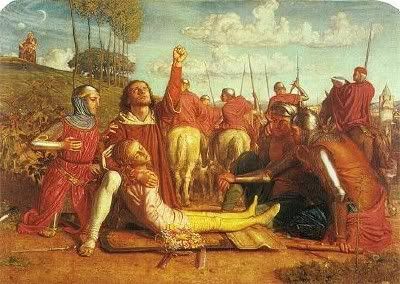Welcome to the April 5, 2011 edition of art history carnival.
art history
Anyone with an interest in art has come across numerous works that have been attributed to famous artists, but the evidence is often lacking. I frequently receive emails from readers asking me my opinion on works they plan to purchase. They often want to know whether I agree with appraisals that claim the sketches/paintings are by Rossetti, etc. When in doubt (which is ever time!) I prefer to err on the side of skepticism. I still find these stories fascinating, however, as I'm sure most of you do.
That's why I found Zsombor Jékely post Botticelli in Esztergom? posted at Medieval Hungary so fascinating. The post examines the history around some frescoes attributed to Botticelli in Esztergom. There's plenty of detail here to provide armchair art history sleuths with arguments for and against the attribution. The frescoes themselves are lovely, but are they by Botticelli? Read and decide for yourselves!
Andy Warhol (seen above looking remarkably nondescript back in 1963 - a year after creating the Marilyn series) produced a plethora of iconic artworks, among which the Marilyn Diptych stands out as a piece of modern art so ubiquitous that it's become dull - which is doubtless exactly what Warhol would have wanted. (As an aside, I sometimes wonder what he would think of those dreadful "Warhol-inspired" photos of suburban couples that interior designers seem to think are so clever. Argh). Anyway, I was pleased to see the lesser-known Gold Marilyn being featured by Susan Benford in her post Famous Paintings: Gold Marilyn posted at Famous Paintings Reviewed - An Art History Blog.
H Niyazi's Not Renaissance: Marian symbolism & the constancy of Virgil posted at Three Pipe Problem examines themes found in artistic representations of the Virgin Mary during the Renaissance. Niyazi notes that "the Renaissance is commonly described as a rebirth of learning from antiquity. It was also the inheritor of rich visual and literary traditions that persisted through the Early Christian and Middle Ages. This post examines two of the most prominent of these." Not to give too much of a spoiler, but I found Niyazi's discussion of depictions of the Virgin Mary breastfeeding quite fascinating! (Fun fact: did you know the Council of Trent "forbade the depiction of the Nursing Virgin due to the nudity suggested by the exposed breast"?!).
Pre-Raphaelite paintings are filled with symbolism. It can take hours to find all the little details that the artists have put into their work. This is true of almost all of the paintings produced up until the middle of the last century. The symbolic language of the plants found within paintings is a world unto itself. It would take me forever to learn what every flower means! David Packwood's piece Landscape and Symbol: The Secret Life of Plants. posted at Art History Today examines the use of dandelions--in particular--and landscape--in general--in both Renaissance and Pre-Raphaelite art. Dandelions abound in William Holman Hunt's Rienzi (shown above) and can also be seen in Raphael's Entombment. Are there any parallels in the artists' use of these motifs? Read for yourself!
architecture
The romance of luxury travel was once epitomized by the extravagant Orient Express. Helen Webberley has written about efforts to revive the architecture of some of the more iconic stops along the train route in her post Pera Palace Istanbul and the Orient Express posted at ART and ARCHITECTURE, mainly, saying, "At first, limited board and lodgings opened up for European visitors arriving in Istanbul. But when the worldwide famous Orient Express train chose Istanbul as its last stop in the East in 1883, the monied classes wanted something special. So Compagnie Internationale de Wagon Lits, owners of the Orient Express Train, bought Pera Palace Hotel and made it exquisite. This post looks at the most recent renovation of the hotel, restoring the hotel to its turn-of-the-century beauty." The restored main hall is pictured above.
reviews
Vik Muniz is a Brazilian-born, Brooklyn-based artist who creates art using unusual mediums, such as sugar, wire and chocolate. Gabriela Rusu has done a profile of the artist, with images of some of his works in her post People who inspire me: Vik Muniz posted at Gabriela Rusu Fine Art.
Finally, on the lighter side, I ran across something that many of you will probably not consider art, but it made me smile. Inside Beat an arts and entertainment blog, sent me a link to a post with images from the Bent Objects website. Bent Objects uses wire and everyday objects to create darkly amusing vignettes (reminiscent of Far Side cartoons). Have fun!
That concludes this edition. Submit your blog article to the next edition of
art history carnival
using our
carnival submission form.
Past posts and future hosts can be found on our
blog carnival index page.
Technorati tags:
art history carnival, blog carnival.







4 comments:
It has been a delightful month for art history blog posts! I am very pleased to have my 'Virgo Lactans' piece selected, I put a bit extra into that one and have received some amazing feedback.
Also, glad to see some new sites and resources to explore!
Many thanks to Margaret for her ongoing hard work!
H
Dear Margaret, thanks for including my post in this issue. I will provide an update as soon as I hear something new about the Esztergom frescoes.
Zsombor
@H Niyazi - Thanks so much for your comment, H! I had a lot of fun reading this month's submissions :)
@Zsombor Jekely - Thanks, and I definitely am looking forward to hearing more about the frescoes!
And you included Bent Objects - what fun! An email has just been circulating at work with several pictures of these wire wonders. They're so imaginative.
Post a Comment